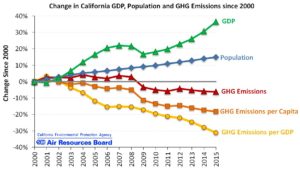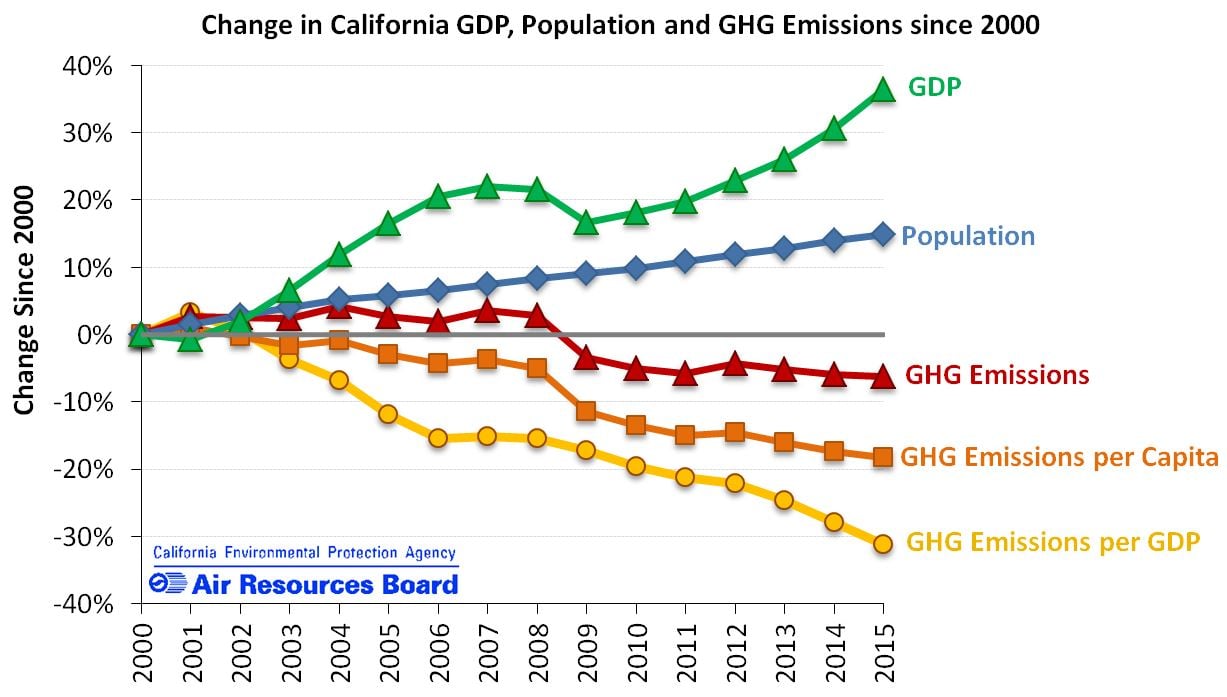Fantastic is reducing greenhouse gas (GHG) emissions. More fantastic is fewer GHGs and an economy growing simultaneously, and, such is precisely the case in California.
Speaking to this, the California Environmental Protection Agency Air Resources Board (ARB) declared: “Demonstrating California’s progress toward a clean-energy economy, the California Air Resources Board today [Jun. 7, 2017] released the latest statewide inventory of greenhouse gas emissions, a report showing significant emissions reductions along with the strongest economic growth since 2005.

“‘This data shows once again that California’s groundbreaking greenhouse gas emission-reduction programs are working as designed,’ said Mary D. Nichols, Chair of the California Air Resources Board (CARB). ‘These numbers clearly indicate that the state is on track to achieve its 2020 emission reduction goals and that California can grow its economy while continuing to fight climate change.’”
In the report, the 2015 Greenhouse Gas Emissions Inventory, shown is that heat-trapping GHGs in state declined by 1.5 million metric tons in 2015 relative to 2014. That’s, in essence, analogous to taking 300,000 internal-combustion-engine-powered motor vehicles and relegating them in California to non-operational status for an entire year.
Adds ARB: “… In the last seven years, California has created 2.3 million new jobs – outpacing most of the U.S. – cut its unemployment rate in half, eliminated a $27 billion budget deficit and has seen its credit rating rise to the highest level in more than a decade. In 2016, California led the nation in job creation for the third straight year.”
A goal of lowering state GHGs to the level in 1990 by 2020 was set, a condition called for in the Global Warming Solutions Act of 2006 (California Assembly Bill 32). “… Since the peak of 489 MMT [million metric tons] in 2004, statewide emissions have declined by 10 percent, with the latest inventory showing emissions of 440 MMT in 2015,” ARB noted.
The reasons for the drop in emissions are several. Among them are:
- Renewables Portfolio Standard
- Advanced Clean Cars Program
- Low Carbon Fuel Standard
- Cap-and-Trade Program
Other areas saw improvement as well. “Emissions from industrial sources declined or leveled off. Refinery emissions dropped by 4 percent in 2015, and, despite a surge in construction and highway repair, emissions from the cement sector remained stable in 2015,” the ARB went on to report.
However, all is not good news, ARB affirmed. “Increased fuel consumption in 2015 resulted in a 3 percent increase in emissions from the transportation sector, which is the state’s largest source of greenhouse gases with 37 percent of statewide emissions. As a result of the state’s Low Carbon Fuel Standard, however, cleaner renewable fuels are continuing to replace gasoline and diesel fuels. In 2015 biofuels displaced more than one billion gallons of gasoline and over 300 million gallons of diesel fuel.”
To learn more, see: “New Report Shows California is Reducing Greenhouse Gas Emissions as Economy Continues to Grow,” a California Environmental Protection Agency Air Resources Board, Jun. 7, 2017 news release here.
This post was last revised on Dec. 3, 2020 @ 6:24 a.m. Pacific Standard Time.
– Alan Kandel

Great news and report. Lots of hard work showing great results! Go green!
I would imagine with the shortage of water in California that it is the way the vegetation is no longer allowed to spread means that less fuel is needed to both harvest and to destroy it.